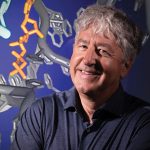Professor Satchin Panda and team, in collaboration with UC San Diego and the San Diego Fire-Rescue Department, conducted a clinical trial and found that time-restricted eating improved measures of health and wellbeing in firefighters. Eating during a 10-hour window decreased firefighters’ “bad” cholesterol and alcohol intake, as well as improved their mental health, blood sugar, and blood pressure. The researchers also discovered that time-restricted eating may provide even greater benefits for those at risk for cardiometabolic disease and other chronic diseases.
Discoveries
Anti-inflammatory molecules that decline in the aging brain
Aging involves complicated plot twists and a large cast of characters: inflammation, stress, metabolic changes, and many others. Professor Alan Saghatelian, Senior Research Associate Dan Tan, and colleagues, in collaboration with UC San Diego, revealed another factor implicated in the aging process—a class of lipids called SGDGs, which decline in the brain with age and may have anti-inflammatory effects. The finding could have implications for neurodegenerative disorders and other conditions that involve increased brain inflammation.
Read News ReleaseGrowing motor neurons guided by “love-hate relationship” with blood vessels
When neurons involved in movement—called motor neurons—form, they must build connections that reach from the brain, brainstem, or spinal cord all the way to the toes. Now, Professor Samuel Pfaff, his team, and colleagues at the San Raffaele Scientific Institute in Italy provide a new understanding of how a “push-pull” relationship with blood vessels—in which growing neurons both attract blood vessels to them while also pushing them out of the way—guides the growth and development of motor neurons. Their discovery has implications for diseases in which motor neuron connections are destroyed, such as amyotrophic lateral sclerosis (ALS) or spinal muscular atrophy (SMA).
Read News ReleaseThe brain’s ability to perceive space expands like the universe
As we move about in our daily lives, we tend to think that we navigate space in a linear way—but our brain does not always act in a linear manner. Professor Tatyana Sharpee, graduate student Huanqiu Zhang, and colleagues discovered that time spent exploring an environment causes neural representations to grow in surprising ways. Neurons in the hippocampus, essential for spatial navigation, memory, and planning, represent space in a manner that conforms to a nonlinear hyperbolic geometry—a three-dimensional expanse that grows outward exponentially (like the interior of an expanding hourglass). This discovery provides valuable methods for analyzing data on neurocognitive disorders involving learning and memory, such as Alzheimer’s disease.
Read News ReleaseSalk scientists develop compound that reverses gut inflammation in mice
A drug developed by Salk Institute researchers acts like a master reset switch in the intestines. The compound, called FexD, was previously found to lower cholesterol, burn fat, and ward off colorectal cancer in mice. Now, co-corresponding authors Professor Ronald Evans and Senior Staff Scientist Michael Downes and colleagues have found that FexD can also prevent and reverse intestinal inflammation in mouse models of inflammatory bowel disease, an umbrella diagnosis that includes both Crohn’s disease and ulcerative colitis. Their research provides new, important information about the complex link between gut health and inflammation that has the potential to lead to an inflammatory bowel disease therapeutic.
Read News ReleaseDeteriorating neurons are source of human brain inflammation in Alzheimer’s disease
Despite decades of research, Alzheimer’s disease remains a debilitating and eventually fatal dementia with no effective treatment options. Now, Professor Rusty Gage, graduate student Joseph Herdy, and colleagues have found that neurons from people with Alzheimer’s disease show deterioration and undergo a late-life stress process, called senescence. These neurons have a loss of functional activity, impaired metabolism, and increased brain inflammation. Additionally, the team discovered that targeting these deteriorating neurons with therapeutics could be an effective strategy for preventing or treating Alzheimer’s disease.
Read News ReleaseGenetic changes that turn “on” cancer genes
In addition to communicating with other cells, cells also have an internal monologue—one that occurs as they regulate gene activity. Assistant Professor Jesse Dixon, Postdoctoral Fellow Zhichao Xu, and colleagues have zeroed in on the specific mechanisms that activate oncogenes—altered genes that can cause normal cells to become cancerous. Cancer can be caused by genetic mutations, yet the impact of specific types, such as structural variants that break and rejoin DNA, can vary widely. The researchers found that genetic mutation activity depends on the distance between a particular gene and the sequences that regulate the gene, as well as on the activity level of the regulatory genetic sequences involved. The work advances the ability to predict and interpret which genetic mutations found in cancer genomes are causing the disease.
Time-restricted eating reshapes gene expression throughout the body
Numerous studies have shown health benefits from time-restricted eating, making practices like intermittent fasting a hot topic in the wellness industry. Now, Professor Satchin Panda and team show how time-restricted eating influences gene expression across more than 22 regions of the body and brain in mice. The team found a system-wide, molecular impact of time-restricted eating in mice, and noted that the time-restricted eating aligned the circadian rhythms of multiple organs in the body. The findings have implications for a wide range of health conditions, such as diabetes, heart disease, and cancer.
Read News ReleaseSupplementation with amino acid serine eases neuropathy in diabetic mice
Approximately half of people with type 1 or type 2 diabetes experience peripheral neuropathy—weakness, numbness, and pain, primarily in the hands and feet. Now, working in mice, Professor Christian Metallo, Postdoctoral Fellow Michal Handzlik, and colleagues have identified another factor contributing to diabetes-associated peripheral neuropathy: altered amino acid metabolism. The researchers were able to alleviate neuropathy symptoms in diabetic mice by supplementing their diets with the amino acid serine. The findings may provide a new way to identify people at high risk for peripheral neuropathy, as well as a potential treatment option.
Read News ReleaseThree hallmarks of aging work together to prevent cancer
Communication is key for warding off cancerous cells. As we age, the end caps of our chromosomes, called telomeres, gradually shorten. Professors Jan Karlseder and Gerald Shadel and colleagues have discovered that when telomeres become very short, they communicate with mitochondria, the cell’s powerhouses. This communication triggers a complex set of signaling pathways and initiates an inflammatory response that destroys cells that could otherwise become cancerous. These findings could lead to new ways of preventing and treating cancer, as well as designing better interventions to offset the harmful consequences of aging.
Read News ReleaseMicroprotein increases appetite in mice
Salk scientists study how biological processes, like metabolism, can be used to improve cancer treatment outcomes. Tiny proteins, called microproteins, have long been overlooked in obesity and metabolic disease research. Now, Professor Alan Saghatelian and colleagues at UC Irvine have discovered that both brown and white fat are filled with thousands of previously unknown microproteins. They also showed that administering one of these microproteins, called Gm8773, can increase appetite in mice. Their findings may lead to the development of a therapeutic to help people gain weight in certain disease situations, such as during chemotherapy for cancer.
Read News ReleaseFeatured Stories
 Journey of a lifetime—The Cancer Center at Salk celebrates 50 years of life-changing discoveriesSalk’s Cancer Center has become a powerhouse of critical discoveries that have led to treatments and remissions for patients. The Center’s mission is to make current generations the last to see cancer as anything other than a routine diagnosis.
Journey of a lifetime—The Cancer Center at Salk celebrates 50 years of life-changing discoveriesSalk’s Cancer Center has become a powerhouse of critical discoveries that have led to treatments and remissions for patients. The Center’s mission is to make current generations the last to see cancer as anything other than a routine diagnosis.  Introducing Salk’s newest president, Gerald JoyceJoyce, a pioneer in the field of test-tube evolution, succeeds Professor Rusty Gage, who will return to his lab following a transformative leadership tenure. Joyce assumed the role April 21, 2023.
Introducing Salk’s newest president, Gerald JoyceJoyce, a pioneer in the field of test-tube evolution, succeeds Professor Rusty Gage, who will return to his lab following a transformative leadership tenure. Joyce assumed the role April 21, 2023.  Reuben Shaw—Unexpected resultsIt’s not every day a young scientist gets a jaw-dropping result he knows no one will believe. But that’s exactly what happened to Professor Reuben Shaw 20 years ago, in the spring of 2003.
Reuben Shaw—Unexpected resultsIt’s not every day a young scientist gets a jaw-dropping result he knows no one will believe. But that’s exactly what happened to Professor Reuben Shaw 20 years ago, in the spring of 2003.
 Tony Hunter—How an animal virus discovery more than 40 years ago led to one of today’s most successful cancer drugsThe story behind how Hunter discovered the first kinase that phosphorylates the amino acid tyrosine. The finding led to the development of Gleevec, a medication that is now routinely used to treat chronic myelogenous leukemia (CML).
Tony Hunter—How an animal virus discovery more than 40 years ago led to one of today’s most successful cancer drugsThe story behind how Hunter discovered the first kinase that phosphorylates the amino acid tyrosine. The finding led to the development of Gleevec, a medication that is now routinely used to treat chronic myelogenous leukemia (CML). Charles Stevens—A beautiful mind, and a heart to matchA pioneer in neuroscience, Distinguished Professor Emeritus Charles F. Stevens died peacefully on October 21, 2022, at his home in San Diego. He was 88.
Charles Stevens—A beautiful mind, and a heart to matchA pioneer in neuroscience, Distinguished Professor Emeritus Charles F. Stevens died peacefully on October 21, 2022, at his home in San Diego. He was 88. Leona Flores—Rocking cancer researchFlores had studied the design of the Salk Institute as an architectural engineering student, but never did she imagine that she would be the executive director of the Institute’s Cancer Center years later.
Leona Flores—Rocking cancer researchFlores had studied the design of the Salk Institute as an architectural engineering student, but never did she imagine that she would be the executive director of the Institute’s Cancer Center years later. Payel Mondal—Cancer researcher by day, financial planner by nightMondal is a postdoctoral researcher in Assistant Professor Christina Towers’ lab where she studies the mechanisms involved in cancer progression. Her hope is that her projects will someday be translated into therapeutics to help people.
Payel Mondal—Cancer researcher by day, financial planner by nightMondal is a postdoctoral researcher in Assistant Professor Christina Towers’ lab where she studies the mechanisms involved in cancer progression. Her hope is that her projects will someday be translated into therapeutics to help people. Salk receives $1.5 million from the Sol Goldman Charitable Trust and $1.25 million from The Jay and Sarah Flatley FoundationThe Salk Institute is grateful to its many generous supporters.
Salk receives $1.5 million from the Sol Goldman Charitable Trust and $1.25 million from The Jay and Sarah Flatley FoundationThe Salk Institute is grateful to its many generous supporters.





















































